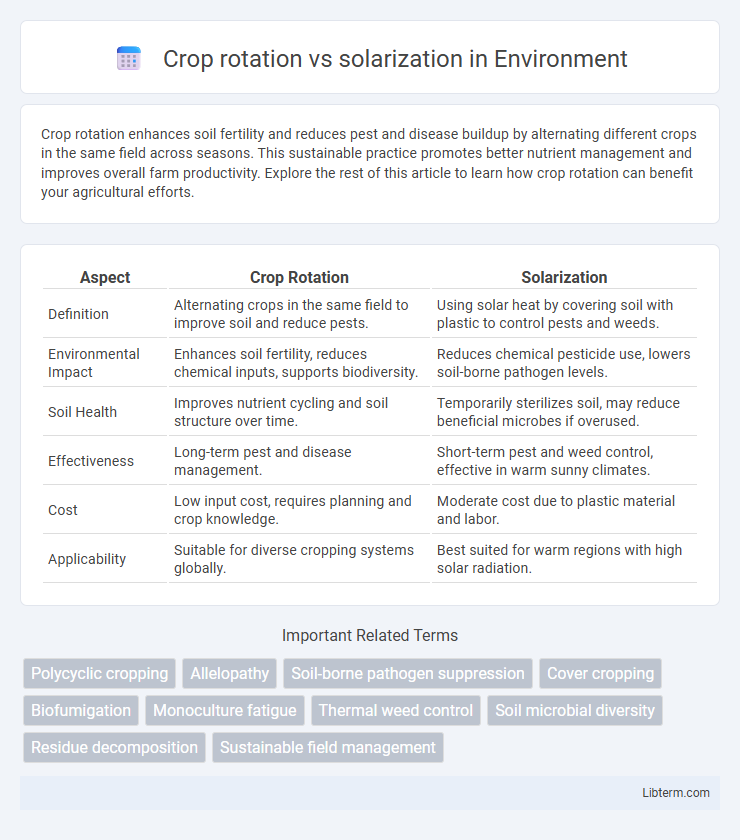Crop rotation enhances soil fertility and reduces pest and disease buildup by alternating different crops in the same field across seasons. This sustainable practice promotes better nutrient management and improves overall farm productivity. Explore the rest of this article to learn how crop rotation can benefit your agricultural efforts.
Table of Comparison
| Aspect | Crop Rotation | Solarization |
|---|---|---|
| Definition | Alternating crops in the same field to improve soil and reduce pests. | Using solar heat by covering soil with plastic to control pests and weeds. |
| Environmental Impact | Enhances soil fertility, reduces chemical inputs, supports biodiversity. | Reduces chemical pesticide use, lowers soil-borne pathogen levels. |
| Soil Health | Improves nutrient cycling and soil structure over time. | Temporarily sterilizes soil, may reduce beneficial microbes if overused. |
| Effectiveness | Long-term pest and disease management. | Short-term pest and weed control, effective in warm sunny climates. |
| Cost | Low input cost, requires planning and crop knowledge. | Moderate cost due to plastic material and labor. |
| Applicability | Suitable for diverse cropping systems globally. | Best suited for warm regions with high solar radiation. |
Introduction to Crop Rotation and Solarization
Crop rotation involves systematically alternating different crops in the same field to improve soil health, manage pests, and increase yield by disrupting pest and disease cycles. Solarization uses clear plastic sheets to trap solar energy, raising soil temperature to levels that kill pathogens, weed seeds, and nematodes without chemicals. Both methods enhance sustainable agriculture by promoting soil vitality and controlling soil-borne problems through natural processes.
Defining Crop Rotation: Principles and Benefits
Crop rotation involves systematically alternating different crops in the same field across seasons to enhance soil fertility, reduce pest and disease cycles, and improve crop yields. Key principles include selecting crops with complementary nutrient needs and rooting depths to optimize soil nutrient use and prevent depletion. Benefits of crop rotation encompass increased biodiversity, enhanced soil structure, and reduced reliance on chemical inputs, promoting sustainable agricultural practices.
Understanding Solarization: Method and Effectiveness
Solarization involves covering soil with clear plastic sheets during sunny periods to trap solar radiation, raising soil temperatures to levels that eliminate pests, weeds, and pathogens. This method effectively reduces soil-borne diseases and improves soil health without chemical treatments, especially in warm climates with abundant sunlight. Crop rotation, while minimizing pest buildup by alternating plant families, does not achieve the same immediate sterilization effects as solarization.
Soil Health Impact: Crop Rotation vs. Solarization
Crop rotation improves soil health by diversifying nutrient use and enhancing microbial diversity, reducing disease pressure and soil erosion. Solarization uses solar heat to sterilize soil, effectively controlling pathogens and weeds but potentially decreasing beneficial microorganisms. Integrating crop rotation with periodic solarization balances soil fertility and pest management for sustainable agriculture.
Weed and Pest Control Strategies Compared
Crop rotation disrupts pest and weed life cycles by alternating plant families, reducing host-specific pest populations and lowering weed seed banks through varied crop shading and root exudates. Solarization uses clear plastic covers to trap solar heat, effectively sterilizing soil by eliminating weed seeds, fungi, nematodes, and soil-borne pests in the upper soil layers. While crop rotation provides long-term pest suppression and soil health benefits, solarization offers a rapid, non-chemical pest and weed control method best suited for warm, sunny climates.
Effects on Soil Fertility and Microbial Balance
Crop rotation enhances soil fertility by diversifying nutrient uptake and reducing pest buildup, promoting a balanced microbial ecosystem. Solarization significantly decreases soil pathogens and weed seeds through controlled heat exposure but may temporarily disrupt beneficial microbial populations. Integrating both methods optimizes long-term soil health by balancing pathogen suppression with microbial diversity restoration.
Crop Yield Outcomes: Rotational Planting vs. Soil Solarization
Crop rotation enhances crop yield outcomes by improving soil fertility, reducing pest and disease cycles, and promoting balanced nutrient availability, which leads to sustainable long-term productivity. Soil solarization increases yields by using solar heat to eliminate soil-borne pathogens and weeds, providing a short-term boost in soil health and crop performance. Rotational planting offers more consistent yield improvements across multiple growing seasons, while solarization delivers rapid, season-specific yield gains primarily in warm climates.
Environmental Sustainability Considerations
Crop rotation enhances environmental sustainability by improving soil health, reducing pest and disease cycles, and minimizing the need for chemical inputs, thereby promoting biodiversity and soil fertility. Solarization uses solar energy to naturally sterilize the soil, effectively reducing soil-borne pathogens and weeds without chemical pesticides, but it requires significant energy input and can disrupt soil microbial communities temporarily. Both methods support sustainable agriculture, with crop rotation favoring long-term ecological balance and solarization offering rapid soil remediation with minimal chemical reliance.
Cost, Labor, and Practicality for Farmers
Crop rotation requires low input costs and minimal labor, making it a practical and sustainable choice for farmers aiming to improve soil health and reduce pest buildup. Solarization involves higher upfront costs for plastic materials and significant labor to lay and remove plastic sheets, which can limit its feasibility for small-scale or resource-limited farms. Farmers must weigh the cost-effectiveness and labor demands of crop rotation against the intensive setup and seasonal timing constraints of solarization.
Which Method to Choose: Factors to Consider
Choosing between crop rotation and solarization depends on factors such as soil type, pest pressure, and crop objectives. Crop rotation improves soil fertility and disrupts pest cycles by alternating plant families, ideal for long-term sustainability. Solarization, which uses solar heat to sterilize soil, is effective for short-term pest and weed control, especially in warm, sunny climates with high soil moisture.
Crop rotation Infographic

 libterm.com
libterm.com